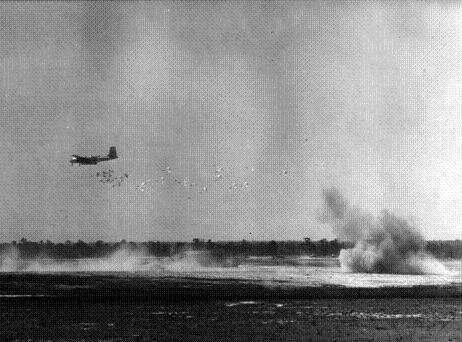![]() The Pacific War Online Encyclopedia
The Pacific War Online Encyclopedia
|
| Previous: Paradip | Table of Contents | Next: Paramushiro |

U.S. Air Force.
Via Truman
Library
The parafrag bomb was invented by Kenney in the 1920s and put to good use in the Southwest Pacific. It was a relatively small bomb (24 pounds or 11 kilograms) scored to break into 1" (25mm) fragments on detonation and equipped with a small parachute. The parachute allowed the bomb to be dropped directly over the target in a low-level attack while allowing the attacking aircraft to get clear before detonation. The low weight allowed a very large number of these weapons to be dropped at once. The effect of a parafrag attack was to saturate a zone half a mile long with bomb fragments. Kenney was able to have 23-pound fragmentation bombs shipped in quantity to the Southwest Pacific, mostly because they weren't wanted anywhere else, and his ground crews then attached the parachutes.
The parafrag bomb was thus an ancestor of both modern laydown bombs and of cluster ammunition. It was highly effective against airfields, since its fragments shredded aluminum airframes and its delivery in large numbers from directly above foiled ordinary aircraft revetments.
The parafrag was standardized by March 1945 as the AN-M40.
A finned version for use from altitude was standardized as the AN-M41,
while a cluster of 25 AN-M41 bombs was standardized as the M26.
The Japanese
copied the idea after examining dud American parafrag bombs, but to
little effect. The Japanese parafrags were much lighter (about 8 pounds
or 3.6 kilograms) and were equipped with an arming propeller that often
malfunctioned, resulting in a high dud rate.
 |
 |  |  |
References
"Bombardier's Information File" (1945-3; accessed 2013-10-19)
The Pacific War Online Encyclopedia © 2007-2008, 2013 by Kent G. Budge. Index